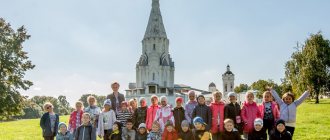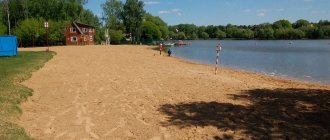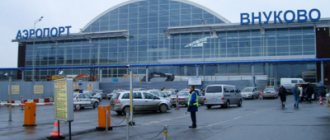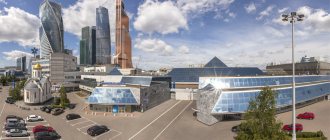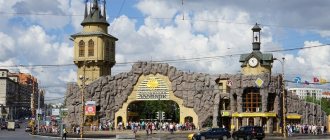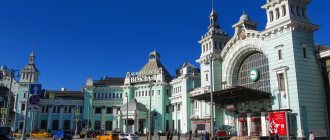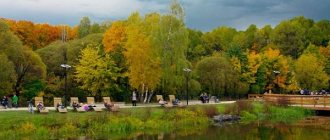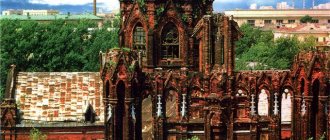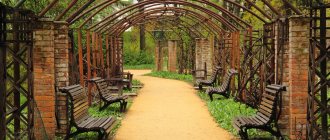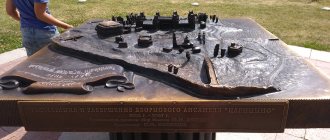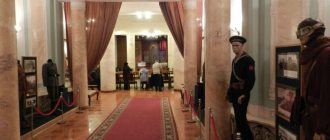Neskuchny Garden is one of the oldest parks in Moscow and at the same time the largest landscape park in the historical center of the capital. Various legends are associated with this place. It began back in the 18th century. Then the territory of the park was divided between several owners. Along the river stood the houses of the Trubetskoys, Orlovs and Golitsyns. At that time, Russian rich people tried to be like Europeans in everything. Paying tribute to European fashion, they surrounded their estates with beautiful, clearly designed parks with rare plants, fountains and sculptures. In the 19th century, all three estates were purchased by the palace department of Nicholas I and combined into one large park. During the Soviet years, Neskuchny Garden was annexed to the Park of Culture and Leisure named after. Gorky. And just a few years ago, renovations were done there, after which areas for sports games, cafes and other infrastructure elements appeared. Muscovites and city guests love to come here at any time of the year. The park with its romantic paths, lovers' alleys, bridges, ancient buildings and gazebos is suitable for both leisurely walks and active recreation.
© Gennady Grachev
Park type
Neskuchny Garden is very popular in the capital. Without exaggeration, all Muscovites know how to get there, and there are many guidebooks for guests of the capital. The network provides detailed routes for any type of transport.
By its type, Neskuchny Garden is a landscape park. Urban forests designed in this direction are also called English, landscape or irregular. Nearby on the right bank of the Moscow River are the Vorobyovy Gory reserve and the central part of the park named after. Gorky, with which Neskuchny Garden forms a common natural complex.
First owner of the palace
Park alleys
The first owner of this palace, Prokofy Demidov, is worth telling separately. He was the eldest son of the owner of the Ural mining factories, Akanfiy Demidov, had a huge fortune and was a real eccentric. For example,
- He could come to a social evening with foreign nobles in bast shoes and with a long stick.
- When glasses came into fashion, Prokofy Demidov put glasses on all the servants, coachmen, footmen, and even on his horses and dogs.
- One hot summer morning, for no apparent reason he wanted to ride a sleigh. No sooner said than done, he bought several tons of salt and sprinkled it three miles away on his estate. I got into the sleigh and rode around in the snow for half an hour, had fun and went about my business in a great mood, and immediately forgot about my fun. And salt, which was in short supply at that time, could be picked up by anyone who wanted it.
But his main hobby was botany. On a steep slope near the Moscow River, Prokofy Demidov laid out terraces for a spacious botanical garden. More than 2000 plants were planted here. Flowers of extraordinary beauty grew in this botanical garden. Therefore, the girls living nearby got into the habit of sneaking here at night. But the eccentric Demidov came up with a way to protect himself once and for all. One evening, he removed several dozen statues of naked ancient heroes placed along the paths. And in their place he put naked serfs, whom he sprinkled with chalk for convincing. Night fell, several dozen young ladies entered the garden and headed towards the flower beds. And then the statues “came to life” and rushed towards them. They say that a good half of the girls fainted.
One of a kind
How good he was can be judged at least from the canvas by A. Ya. Golovin, painted in 1910. Neskuchny Garden has become a favorite place for Muscovites. How to get to it also worried many people because an incredibly popular open-air summer theater was built here. Major foreign masters of instrumental music, gypsy ensembles, and various illusionists also performed there. People came here in droves. The Soviet period also added charm to the garden - the Shrub and Industrial Exhibition was held here in 1923, the best architects of that time, V. A. Shchusev and A. V. Kuznetsov, worked on the design of the pavilions. Thus, the “Makhorka” pavilion by I. V. Zheltovsky entered the history of Soviet architecture.
Nearest metro stops
The Neskuchny Garden contains interesting objects from several eras. How to get to its ancient protected corners? The nearest metro station is Leninsky Prospekt, a little further is Oktyabrskaya. The area is located between Leninsky Prospekt and the Pushkinskaya embankment of the Moscow River, across which the Andreevsky pedestrian bridge leading to Neskuchny Garden is thrown into the park. The metro is within walking distance, and the entrance to the park closest to the Leninsky Prospekt station is located near house No. 30, located along this highway. The main entrance to the park is located at house No. 18. You can also walk along Pushkinskaya Embankment to Neskuchny Garden. From the Frunzenskaya station, you can reach the park in 10 minutes via the aforementioned Andreevsky Bridge.
Landscapes and architecture of the park
The most significant building that has come down to us since the time of the imperial Neskuchny is the Demidovsky, or Alexandrinsky Palace . Once upon a time, back in Catherine's era, the palace was built in Baroque traditions, then it was rebuilt by Count Orlov in the classical style.
Now both facades - the front and the garden - appear in the form that Tyurin gave them during the time of Nicholas the First. The main facade of the building is especially impressive - four pairs of Corinthian columns support a decorative wall, cut through by arches into which the windows of the third floor open.
In front of the flat side projections there are strongly protruding semi-circular balconies on low columns - an original detail that brings lightness to the plastic design of the palace facade. When the palace became the royal residence, the front courtyard was supplemented by the Freiners' and Cavalry's corps, which are still part of the ensemble.
The Demidov Palace was owned by the royal family until the revolution. Then an interesting episode occurs in his history. In the first post-revolutionary decade, the Moscow Furniture Museum was located here.
In the book by Ilf and Petrov “The Twelve Chairs” a description of this museum is given. So it was here that Ostap Bender and Kisa Vorobyaninov were looking for “precious chairs.”
In the 30s, the Presidium of the Academy of Sciences moved here from Leningrad, which is still located in the palace. Therefore, the palace is not always accessible for viewing and only from the outside, although elements from the past life of the palace have been preserved in the interior decoration.
The bathhouse was built in the depths of the ravine above the Elizavetinsky Pond during the Orlovs’ time. It was a pavilion made in a classical style, with a high dome and a terrace, in front of the terrace the dome rested on columns.
Nearby, Delsalle's (architect) romantic grotto was built, lined with rough stone blocks. A bridge was erected over the through grotto; it is also called the Bridge of Lovers . If lovers walk along it holding hands, they will live together happily ever after. And if they kiss while standing on this bridge, they will be together until the grave.
The Garden Bridges, the Stone Bridge and the Grotesque Bridge have approximately the same properties; in Neskuchny Garden there are many bridges laid across the spurs of the Andreevsky ravine back in the 19th century.
The optimism of the Soviet era is perfectly expressed in the “Diver” cascade , which consists of a two-flight stone cascading staircase, an expressive sculpture of a girl preparing to jump into the water. The figures of two boys with fish standing at the foot of the stairs make a particularly funny impression.
In 1947, a Rotunda dedicated to the 800th anniversary of Moscow was installed in the garden. It is a rotunda gazebo made of white stone, decorated inside and out with bas-reliefs depicting important milestones in the history of Moscow and Russia.
All contemplators will be delighted by the Hunting Lodge of the Trubetskoy estate - a round, small, elegantly proportioned building dating back to the 18th century. This house, the only one remaining in the estate, belonged to Nikita Trubetskoy. All fans of intellectual games will certainly recognize this miniature park building as a pavilion in which experts of the television game “What? Where? When?".
From the Oryol estate in Neskuchny Garden, the oldest park pavilion remained - the Summer House of 1796 , it was built of wood and designed in the spirit of classical architecture - a simple symmetrical plan, six columns of the Corinthian order from each larger facade and a one-story gazebo with lattice shutters from every small one.
The house was intended for tea parties in the fresh air. From its high balcony there was a wonderful view of Moscow. In Soviet times, there was a library here for many years; now the house is used as a photo studio. The former Oryol estates partially extend beyond the garden; not far from the entrance to the park there is a former arena where Oryol trotters were ridden.
Now this building houses the interesting Museum of Mineralogy named after. Fersman . The collection includes more than 135 thousand samples of natural stones and minerals from all over the world, meteorites, processed precious stones, works of old and modern stone-cutters. The entire museum is one large hall.
Minerals of all possible shapes and colors are presented. There is even such a showcase - precious stones and, for comparison, fakes for them, which are often impossible to distinguish, since they are not inferior in beauty to real jewelry. And some fakes are even more spectacular than their natural counterparts.
The Museum of Mineralogy is open from Wednesday to Sunday from 11:00 to 17:00, Monday and Tuesday are days off.
How to get to Neskuchny Garden (Moscow)?
Neskuchny Garden is located in the central district of Moscow, the Yakimanka district. It is located between Leninsky Prospekt and the Moscow River (Pushkinskaya Embankment), between Vorobyovy Gory Park (the border runs along the Third Transport Ring) and the Central Park of Culture and Leisure named after. Gorky (the border runs along Titovsky Proezd). For some reason, there are no information signs for “Neskuchny Sad”.
By car
You can enter Neskuchny Garden from Leninsky Prospekt almost everywhere, in the area from building 18 to building 30 (located near the Third Transport Ring). Accordingly, you can leave your car where you find free space on this entire section of Leninsky Prospekt. There is quite a large free parking lot at house 30.
Another parking place is on Leninsky Prospekt near Titovsky Proezd (immediately after building 8k13 on Leninsky Prospekt or on the other side of Leninsky Prospekt near houses 15 and 15a). Through Titovsky Proezd you can enter Neskuchny Garden (located on the left along Titovsky Proezd).
You can also drive to Andreevskaya Embankment (to the intersection with Pushkinskaya Embankment), but there are often a lot of cars there. To get there, you need to turn from the Third Transport Ring onto Kosygina Street, and then take the first turn to the right, onto a small street (near building 32 on Leninsky Prospekt), which leads first along Gagarinskaya Square and then down to the embankment.
Metro
The nearest metro station is Leninsky Prospekt or Ploshchad Gagarina station on the MCC. The closest entrance from these stations is at house number 30 on Leninsky Prospekt (near Gagarinskaya Square).
From the Leninsky Prospekt metro station there is another way to the embankment - go towards Gagarin Square and cross the underground passage straight and all the way to the other side of the square. In front of you you see house 32 (Leninsky Prospekt). Go around it on the right and move towards the river. On the left you will see “Golden Brains” (the building of the USSR Academy of Sciences). Continue straight ahead (Golden Brains remain on the left). Having reached the river view, there will be a descent to the embankment on the right and left. Before descending, pay attention to the observation deck - there is a beautiful view from here. Going down to the embankment, on the left is Vorobyovy Gory, and on the right is Neskuchny Garden.
You can also get to Neskuchny Garden from the metro stations:
“Sparrow Hills” - walk along Andreevskaya embankment (along the Sparrow Hills), to Pushkinskaya embankment (here the Neskuchny Garden begins).
“Oktyabrskaya” - drive or walk along Leninsky Prospekt to the main entrance at building 18 (distance about 1.5 km).
— enter the main entrance of the Central Park of Culture and Leisure named after. Gorky (from the Krymsky Val) and walk through the park to Pushkinskaya Embankment (the beginning of Neskuchny Garden).
— move along Lenisky Prospekt towards the Moscow Ring Road to Titovsky Proezd (located on the right, 300 meters from the metro). Turn onto Titovsky Proezd and go down it to Neskuchny Garden (Neskuchny Garden will be on the left, and Gorky Park on the right).
“Frunzenskaya” (or “Luzhniki” MCC) - walk to Frunzenskaya Embankment along 1st Frunzenskaya Street. On the right you will see a beautiful glass-covered bridge - this is the Pushkinsky Bridge. Cross this picturesque pedestrian bridge to Pushkinskaya Embankment on the other side of the river. On your left will be the Central Park of Culture and Leisure named after. Gorky, and on the right is Neskuchny Garden.
From Frunzenskaya you can go to Neskuchny Garden and across the bridge where the Third Transport Ring passes. This is the Novoandreevsky railway and road bridge - there is a pedestrian path on both sides of the bridge. When you come out to the embankment on the other side of the river, you will see Vorobyovy Gory on your right and Neskuchny Garden on your left.
By motor ship
In the garden, on Pushkinskaya embankment, there is a pier for motor ships “Green Theater”.
Mandatory program
If this is your first time getting acquainted with the nightlife capital, then there are a number of places you can go to in Moscow at night:
- Tverskaya street and its alleys;
- Red Square;
- St Basil's Church;
- Spasskaya Tower;
- building of the Historical Museum;
- Theater Square and Bolshoi Theater;
- Moscow State University building;
- observation deck on Sparrow Hills.
Tourists usually make wishes on Red Square. Also, city guests should definitely take a tour of the Moscow City International Business Center. The lights of the city at night here simply take your breath away.
But if it’s not your first time in the city or you’re just looking for where to go in Moscow at night by car with a girl to have an unusual date, then you’ll have to get creative. Fortunately, the capital of the Russian Federation is a Klondike of such places.
If you love mysticism and want to have a fun and interesting time, then go to Bulgakov’s house on Sadovaya. Night excursions directly related to the work “The Master and Margarita” take place here.
During the cold season, you will be shown an exhibition and told mystical stories. The house has extraordinary energy. Even just being next to him, something tickles the nerves inside. The feeling of mystery and mystical adventure will accompany you for a long time.
It's more interesting here in the summer. In addition to the indoor exhibition, you will be taken to the places mentioned in the work.
Boring Garden
Here are the most romantic alleys and the friendliest squirrels. Neskuchny Garden is the “middle” part of the park, which is usually called historical. The founding date of Neskuchny is considered to be 1728, when Prince Nikita Yuryevich Trubetskoy purchased land on a site near the Kaluga Outpost (now Gagarin Square) from Archimandrite German of the Zaikonospassky School Monastery for 300 rubles. Initially, “a courtyard mansion with trees planted on the banks of the Moscow River” passed to Trubetskoy on a lease basis - the prince had to pay 12 rubles a year for it.
Manage the page: Neskuchny Garden
Edit descriptions and information about services
Answer user questions and reviews
Get access to the page by sending us a request from the establishment's official email
The construction of the estate by Trubetskoy was also a kind of diplomatic move - every weekend, every holiday, especially in the summer, Trubetskoy organized receptions, balls and holidays at his estate. Only the most distinguished, rich and influential people were invited there; the guests were personally chosen by Nikita Yuryevich. Usually the number of guests ranged from 100 to 200, but sometimes this figure reached 300, 400 and even 500 people. Trubetskoy’s receptions followed a fairly “standard” program and always included dinner, card games, a “dance part,” walks through the garden and galleries, various carousels, games and entertainment.
It is thanks to N.Yu. By the middle of the 18th century, Trubetskoy Neskuchny Garden became widely known, primarily among nobles and large industrialists. Many rich, influential people buy land in these places and build their estates. As a result, in the second half of the 18th century, in a fairly small area from the Krymsky Val to the village of Vorobyovo (the modern observation deck), there were up to 15 different estates that belonged to eminent families who left their mark on the history of Neskuchny Garden, Moscow and all of Russia. The owners and territories of the estates changed quite quickly - in half a century, some estates changed 5 owners. Among the most famous inhabitants of Neskuchny, in addition to the Trubetskoys, one can name representatives of the Yaguzhinsky, Shakhovsky, Zubov, Golitsyn, Orlov, Demidov families and even the royal family of the Romanovs.
It is believed that the garden also received its name “Neskuchny” thanks to Prince Nikita Trubetskoy. At receptions, the prince paid special attention to ensuring that every guest had something to do, so that no one was bored and everyone had fun. Based on this analogy of “fun” and “not boring,” the guests began to call Trubetskoy’s estate “Neskuchnoe.” This is where the name “Neskuchny Garden” comes from. According to another version, the name “Neskuchnoye” was invented by Trubetskoy himself, to create a certain image, as if preparing guests in advance for the upcoming entertainment. This version is the most plausible, but there are other more fantastic theories.
Historically, the borders of Neskuchny were: from the south, the Andreevskaya Sloboda, which belonged to the St. Andrew’s Monastery (now on the site of the settlement there is a residential area, the conventional border can be considered a road bridge - the third transport ring), from the north - the territory of the Golitsyns, on which the Golitsyn hospital was built in 1802. After this, the conventional border of the Neskuchny Garden was the Demidov estate and the botanical garden (now the Green Theater).
Please let us know if a location is no longer current or has an inaccurate description.
Companies do better knowing that your review can impact their rating.
History of creation
The area where Neskuchny Garden is located has always attracted attention; it was originally a natural reserve. Numerous ravines cutting through the steep bank of the Moscow River, green hilly slopes, mighty ancient trees, and high cliffs give a picturesque appearance to this corner.
Since pre-Petrine times, there were estates near Moscow of many noble boyars, and then nobles - the Baryatinskys, Yaguzhinskys, Kurakins, but the most prominent owner of this place was Prokopiy Akinfievich Demidov.
He was a very eccentric representative of a well-known family of breeders, a generous benefactor and a passionate gardener and botanist; in the famous portrait by Levitsky he is depicted with a watering can in his greenhouse.
A great original, Demidov ordered that the guards of the botanical garden be dressed in white suits and forced them to make up themselves to resemble the park sculptures.
The watchmen stood motionless and “came to life” only when one of the visitors tried to break a tree branch or plucked beautiful flowers from a flowerbed. That is why Muscovites began to call the garden Neskuchny. But this is only one version of the origin of the unusual name.
Landscapes of the Neskuchny Garden park
The Demidov Botanical Garden appeared on the estate in 1756 and had the shape of an amphitheater. In addition to unusual ornamental shrubs and fruit trees, one could see palm trees, exotic for Russians.
After Demidov, at the very beginning of the 19th century, the famous Count Alexei Orlov, the conqueror of the Turks, the hero of Chesma, became the owner of the estate. The new owner, a breeder of the famous Oryol trotters, built an arena here where horse carousels were held.
Demidov and Orlov’s neighbor was Prince Nikita Trubetskoy, who on his estate with the same name “Neskuchnoye” laid out a regular baroque park with galleries, a menagerie, a poultry house, straight alleys and a stone grotto.
Another plot of these lands belonged to the Golitsyn princes; nearby was the famous Golitsyn Hospital, a monument of Russian architecture by Matvey Kazakov, which can still be seen, but only from Leninsky Prospekt.
By the 20s of the 19th century, these lands, which had become a favorite place for celebrations and entertainment, had lost their former significance for their owners, and as a result, all three estates became imperial property.
Orlov's summer house of 1796 in Neskuchny Garden
After the acquisition of Neskuchny by the palace department, Moscow architect E.D. Tyurin was tasked with bringing it in line with the tastes and needs of the new owners. The Demidov Baroque Palace was renovated in the Empire spirit and renamed Alexandrinsky, since Neskuchnoye was presented by Nicholas I to Empress Alexandra Feodorovna.
The park takes on a modern shape and becomes a landscape. The main highlight of the new Neskuchny Garden was the Summer Air Theater, where the best actors played and where all of Moscow came.
